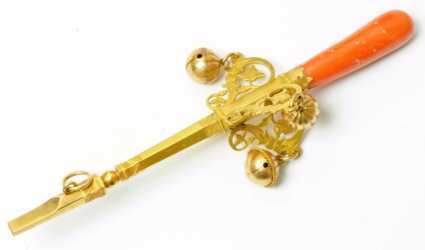(click on photos to enlarge image)
FRENCH TRADITIONAL JEWELLERY
BAPTISM
The arrival of a baby in a family has always been a special moment. Before the 20th century, the rate of neo-natal mortality was quite high and it was considered important to baptise the newborn as rapidly as possible. Before or during the ceremony, the immediate family and very often the god-mother or god-father would offer a small gift: a brooch for fixing the bib, a baby bracelet, a gold or silver medal, a silver beaker or possibly a silver rattle.
Antique baby cups or beakers
Old baby cups or beakers were always made of solid silver, because the malleability of silver permitted a very fine and light result, therefore easy for the baby to hold. A baby cup in brass would be heavier and likely to turn green, while wood, glass or china would be broken within a few days. The numerous dents one sees on antique cups show clearly how many times they fell to the ground.
Tulip shaped silver cups are often found with 18th century hallmarks. I have not been able to pin down their exact use. I suspect that they may well be marriage or loving cups, as they would have been far too expensive to be given to children in the 18th century and they rarely have many dents.
Baby cups are still sold today to maintain the tradition, generally in silver plate. Don't buy them! Too heavy and not designed to be held easily by a baby's hand, they are doomed to blacken in a cupboard. Far better to offer a dozen bibs to the new parents, they'll never have enough!
silver baby cup or beaker c. 1880 (left), silver baby cup engraved 1903 (center) and antique silver baby beaker (right)
Antique baby rattles and teethers
The oldest teether/rattles, from the 18th century to the start of the 19th were often very finely worked, with little bells and with a handle of mother-of-pearl or coral, reputed to have protective effects for teething. These elaborate rattles were not normally left with the baby but instead were worn by the nanny or the mother on a long chain around the neck and used to distract and amuse the baby when necessary.
The large ring in ivory or bone of the later rattle handles was designed to be chewed by the baby to help with teething. Sometimes the baby was given a necklace of balls of ivory, amber, bone or horn with the same purpose.
Antique baby rattle/whistle in silver with ivory teether (left),
baby rattle / teether / whistle in gold and coral, France circa 1810 (center)
and antique art nouveau baby rattle in silver and Galalith (right)
Antique baby service and cutlery sets
Another traditional gift often offered for the baptism was a cutlery set, more or less extensive. At a minimum it would consist of a spoon and a fork, but one sees more complete services which have, in addition, a serviette ring, baby cup, plate, feeding spoon and an egg-cup with its spoon. The feeding spoon, with its silver handle and ivory bowl (after 1900 generally in Celluloid) was often given at the birth of the first child and used later to feed the subsequent siblings.
A basic cutlery service comprising a spoon, fork and silver cup was required for entry into a boarding school and one frequently finds them engraved with the name of the child or some numbers for identification.
Silver baby service (left) and child's cutlery set (right)
Baby tooth jewellery
The first baby teeth to come out were sometimes mounted in a ring or brooch and worn by the mother.
These rings were often given or lent by the mother to a sister or friend having trouble conceiving, the belief being that the wearing of this ring would aid in conception (and that it was up to the woman to remedy the problem, not the man......)
Gold brooch set with four baby teeth and diamonds (top),
pendant with baby's tooth and pearl, gold (center)
and gold ring set with two baby teeth (bottom)
For the baptism a medal in gold or silver was offered for the baby to wear around its neck during the ceremony and sometimes an angel or cross in ivory was suspended above the crib.
Christening medallions in gold with plique-Ó-jour enamel (left),
guardian angel medal in silver (center)
and baptismal medal in gold, Saint John (right)
Crosses for use during the christening ceremony and placing over the crib.
Ivory cross for crib (left) and two galalith cross for crib (center and right)
Small baby brooches offered to the mother and used to fix the baby's bib
Gold baby brooches
Marc Faygen
- 2017 - |
Marc Faygen started collecting antique silver in 1974 at the age of 14, and after many years he is still going strong. His speciality however is French regional and traditional jewellery, of which he is the foremost expert.
This article is an authorised abstract from a page of his site http://www.bijouxregionaux.fr/en/contenu.php?idcontenu=1.
The site is entitled "The jewels of the French" and explores the affection the French have with their jewellery as well as all their other objects in gold and silver. Despite that silverware is not a priority of the website, I believe that many of ASCAS readers will find matter of interest in its pages. |
|



















